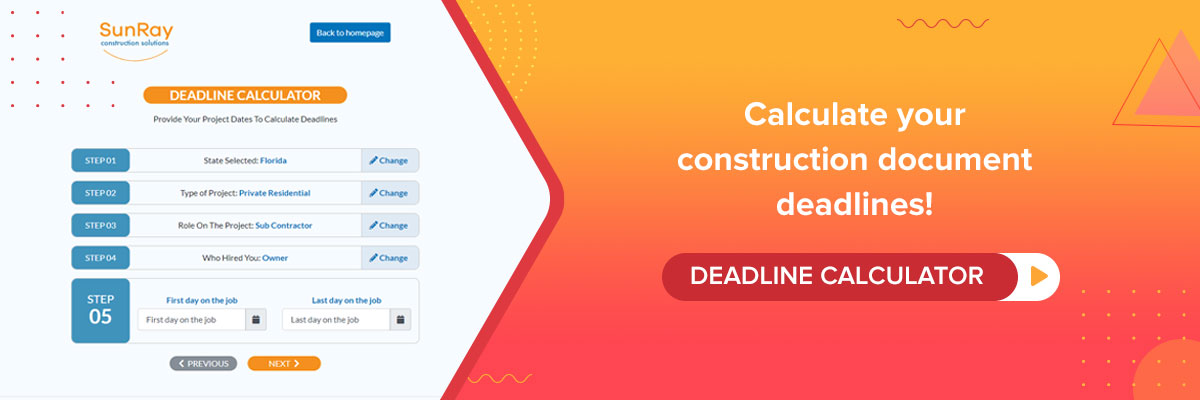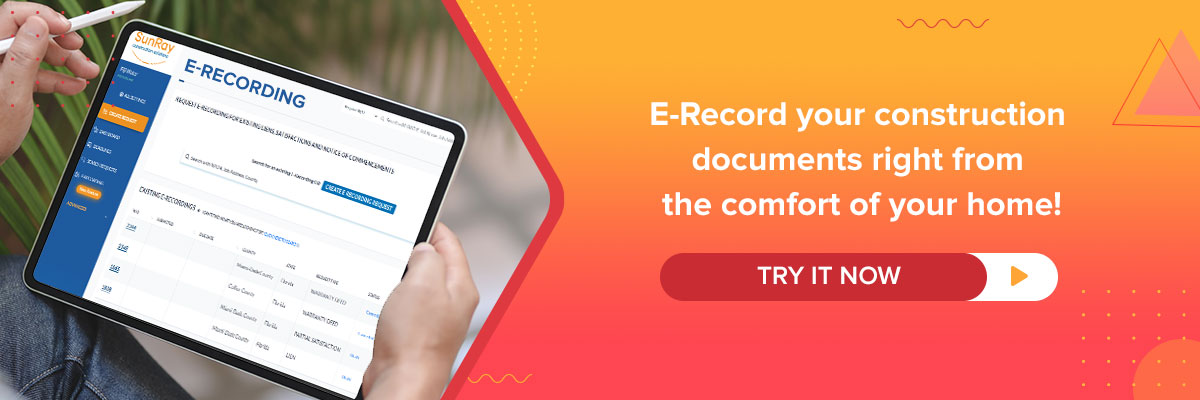Notice of Furnishing, Lien and Bond Claim Refresher (with Pro-Tips) in Ohio - Webinar
About the mechanics lien Ohio, Notice of Commencement Ohio, Notice of Furnishing Ohio, filing a lien and bond claims in Ohio.
Last updated:
Dec
17
,
2025
Published:
Apr 01, 2022
12 Mins
Read
In the state of Ohio, learn about the purpose of liens and bonds, private project Mechanic’s Liens, private project Notice of Furnishing, serve your Notice of Furnishing Ohio, Notice of Commencement Ohio, the deadline to File Mechanic’s Lien Ohio, mechanic’s liens and retainage, private project Bond Claims, public project liens, public project Notice of Commencement, how to service/filing a lien, and Ohio public project Bond Claims.
The Purpose of Liens and Bonds
In the technical notes in the back of the legislation, it talks about mechanic’s liens being there for you to be able to secure payment for the fruits of your labor and work. It is kind of like a mortgage on a home. You buy your home, you use a bank, the bank loans you money, and you in turn give them a security interest in your house.
Here, you are the lender. You are loaning your money to the contractor you work for to both the subcontractor you work for, and the owner you work for. You are improving the property of the owner. So, in private mechanic’s liens, you get to file a lien against the real estate the same way a mortgage is filed against your house.
Private Project Mechanic’s Liens
a. The process
The whole process to do that is to start your work, obtain the Notice of Commencement, and serve your Notice of Furnishing. The process of serving a Notice of Furnishing is deceptively difficult. It looks on its face like it is really the simplest thing to do.
When the Ohio law came out in 1991, it seemed like everyone was going to get paid, there were not going to be any problems, and there were not going to be any more mechanic’s liens. There have been fewer mechanic’s liens but there are also a whole lot of issues that arise because of improper Notices of Furnishing.
Whether you do it yourself or have a service do it, there are a lot of services that are just not really on top of it. They try to be one flavor for the entire United States, but every state is different. So, if you are going to use a service, you should use SunRay, because we do it right and take responsibility for it.

Other services may file documents the same way they would in Texas, in Florida and Ohio. Every state has its own set of laws though. Mechanic’s lien laws are creatures of statutes, and the statutes are different from state to state.
b. Be careful with lien waivers
Along the way, just be careful with waivers. They start in your contract, but they also go through every time you get a payment.
c. Finish your scope of work
Always finish your scope of work.
d. Get paid in full including retainage
Always try to get paid in full.
e. If you do not get paid.
If you do not get paid, file a mechanic’s lien, or you can serve a bond claim too.
f. Get paid
After you get your mechanic’s lien filed, then you should try again to get paid in full.
g. Release your lien
After getting paid, you should release your lien.
Private Project Notice of Furnishing
a. Deadline for serving your Notice of Furnishing
There is a deadline for serving your Notice of Furnishing.
There used to be a too early deadline. In one case that had bad lawyering and bad judging in Ohio, it said that you can file a Notice of Furnishing too early and that is halfway true. That halfway true is as the statute says, once a Notice of Commencement is filed, you can serve your Notice of Furnishing.
Well, the judge misconstrued a lot of things because the lawyers did a bad job and it turned out you could not serve your Notice of Furnishing until after work started. That changed three years ago. There was a case some time ago and the statute says you can serve your Notice of Furnishing at any time after the Notice of Commencement is filed up to 21 days from your first date of work on the project.
If you do not get your Notice of Furnishing filed on time, it does not mean you cannot do it at all. In fact, it is better late than never. If you have not done it, like if you forgot, and it is not Day 22, you can still send it. The only thing you lose is one day of mechanic’s lien rights. That 21-day window slides along. If you serve it on Day 22 you lose Day 1. If you serve it on Day 100, you lose the first 79 days.
It is self-curing to an extent unless you happen to be a supplier and you serve or deliver all of your materials to the project on Day 1, but you serve it on Day 22. You really have no lien rights.
There are two exceptions to this, and two exceptions only. You may believe that if no Notice of Commencement is filed, you do not have to serve a Notice of Furnishing. And if you reserve a request for a Notice of Commencement and they do not get it to you in ten days, you still do not have to do your Notice of Furnishing.
You would be wrong on both counts. The point of serving a Notice of Furnishing is to give you mechanic’s lien rights. But you do not just want to file a mechanic’s lien, you want to get paid. Serving your Notice of Furnishing gets you on the list to get paid.

Because what it does is it lets the owner and the original contractor or general contractor know that you are working on the job. It also lets them know that they should be expecting lien waivers from you, either from the last payment that you got, or from the last payment that they made to the contractor, who made it to the subcontractor, and made it to you. However that is going to work.
So, if it works the way the statute anticipates, the general contractor is going to pay you upfront. But this never happens. Regardless of what the statute says, the way this really should work is that regardless of what happens, you should get your Notice of Furnishing served and then do your lien waivers correctly.
Regardless of whether there is a Notice of Commencement filed or they have failed to respond to your request for Notice of Commencement, get your Notice of Furnishing done anyway. In fact, the proper way to do it is to serve your Notice of Furnishing at the same time that you are doing your Notice of Commencement. This is because it kills two birds with one stone.
b. Serve your Notice of Furnishing
To serve your Notice of Furnishing you can get it to them or serve it on the owner and general contractor any way that gets a written receipt. You can serve it on them by sheriff if you want, since it says so in the statute. The statute does not really prefer that though, it prefers that you send it by certified mail. So much so that if you send your Notice of Furnishing to the address that is listed in the Notice of Commencement, your Notice of Furnishing is deemed to be served as of the day you mail it.
Everything else in the statute is not the day you mail, but the day it is received. They really like certified mail for Notices of Furnishing.
c. Serve on owner/owner’s designee/original contractor
It does not matter who you are, you are always going to have to serve your notice on the owner or the owner’s designee. If you are not in a direct contract with the original contractor, who is someone who has a contract with the owner, you always have to serve it on the original contractor too.
So, at least it is going to be the owner or if the Notice of Commencement has the owner’s designee, forget the owner at that point and serve it on the original contractor.
Can you serve it on anyone else? Yes. When you serve a Notice of Furnishing, particularly if it is a good-sized job, you should serve it on everyone in the chain ahead of you. The important thing is that you get on everyone’s list to keep you from having to file a mechanic’s lien. So, get on the list.
Notice of Commencement
The Notice of Commencement is a document that is a quid pro quo. When the mechanic’s lien law changed in 1991, you had to do this Notice of Furnishing. But that was not fair, and so in its place Ohio copied Michigan and Florida, and kind of glued the two together, shuffled it around a little, and came up with the Notice of Commencement.
The Notice of Commencement tells you (the subcontractor or supplier), absolutely everything you need to know about filing a mechanic’s lien relative to a particular project - that being said, a description of the project, and the name of the owner or contracting party (it does not have to be an owner, it could be a lessee, or land contract vendee who is not the actual owner). It will identify who it is, so you know upon whom you have served the Notice of Furnishing.
It may also have an owner’s designee. If there is an owner’s designee, you must serve the owner’s designee in lieu of serving the owner. It is an extra $6 for certified mail, but who cares? If it gets you paid, it gets you paid.
It also identifies the original contractor, and the date the contract was signed. The latter can be helpful because you get an idea particularly if you are working on a project where there are a number of different projects going on at the same site. Or there might be a past one and now there is this one that is more in line with you.
So, you can kind of figure out which one you are working on by that. It also tells you if there is a surety, so that you might be able to file a bond claim. It mentions a lender and it also has, most importantly, the legal description. If you are going to file a lien, you need the right legal description. So, get that Notice of Commencement.
Sometimes it is easy to find and sometimes it is almost impossible, and you end up having to try and prove a negative that there was not one filed.
Deadline to File Mechanic’s Liens
The deadline to file a mechanic’s lien depends on the type of project.
a. For residential project or single-condominium unit
If you are working on a single-family home, a one- or two-family residential project, or a single unit of a condominium, you have 60 days to file a mechanic’s lien.

b. All others, except oil and gas or public projects
On everything except public or oil and gas, you have 75 days to file. So, now we moved away from the Notice of Furnishing, and we have actually gotten into doing the mechanic’s lien.
What if you are completely out of lien rights? Should you still serve a Notice of Furnishing? It depends; do you want mechanic’s lien rights, or do you want to get on the list? Get on the list. You can still serve it even if you are very late. You can serve on long projects 300 days late, but it still has you in line to get paid. It works really well.
So, after you get the Notice of Furnishing done and finished your work, you can file a mechanic’s lien early. We recommend that you do not. Because there is almost no time unless you just want to kick someone in the ribs so that you can serve a mechanic’s lien after you finish your work.
Mechanic’s Liens and Retainage
Now with retainage on commercial and public projects there is always retainage. People say you filed this lien and you filed it too early, you filed it on everything, and you are not owed the retainage yet, so you have to take that lien off.
But no, that amount is still due, it is just not yet payable. So, any time money is due on a contract, you could file a mechanic’s lien every day you are working on a job. You could file every hour if you wanted because more money becomes due. But if you want to cover your retainage, you still have to file within the 60 or 75 days.
For the retainage part, if you say you do not want to file for the retainage because it is not due yet and want to hold off, you can hold off. You will lose your mechanic’s lien rights but you can hold off. Because it is 75 days from your last day of work, not 75 days from the date the money was due to you.
So, your retainage might not be payable for a year or more. You still have to file a mechanic’s lien within 60 or 75 days of your last day of work on the project. Sometimes you can fix it. You can make an arrangement with contractors you are in a good relationship with.
As a subcontractor you may not want to file a mechanic’s lien, so you can go to the contractor and ask for a change order for a little more work, to get 75 more days. The contractor will feel happy that you are working with them to keep a lien-free job, and everyone is in the better part at that point.
Private Project Bond Claims
a. All by contract
If you are going to do a bond claim, first of all on private projects, there are almost never bonds. About the only time you see bonds is on a huge private project or on some of the larger private projects. You can see them on some public projects too where you have the prime contractor/the original contractor/principal contractor, whether you are talking about a prime contractor on federal, original which is private, or principal which is public.

Those bonds are going to be there, but there also may be back bonds from subcontractors up. Those will not be listed in the Notice of Commencement. However, you will find out if you file a bond claim immediately that if you serve that bond claim on the contractor, the response is going to be to not make a bond claim on the other party, and that there is a subcontractor’s back bond, so you should file your bond claim against that.
But this is an incorrect response. You will do that too, but you should not release the bond against them.
The rules on filing bond claims on private projects are all by contract. It is not in the statute so you cannot follow the statute at all. You have to read the bond which is sometimes difficult to get. You have to read the bond to know what they are. So, you may be relying on public bond rules that might be right or completely wrong.
Better safe than sorry, if you do not wait to get to the bond to read it, and file your bond claim early and often. It is better to just protect yourself and say you are sorry later.
Public Project Liens
Now we move on to state and local public construction projects.
a. Notice of Furnishing
State and local projects are a little different. On Notice of Furnishing there are the same general rules, except you never have to serve the owner because you cannot file a lien against the owner’s property. It is public property so you cannot lien it.
What happens in public jobs is, the money that is still due from the public authority to the principal contractor is what is liened. So, there is no reason to need to serve the owner, but you should anyway. Because they ask for lien waivers. They do not need to, but they always do. So, you need to get on their list.
So just send by certified postage for $6. Get it done and get it served on everyone whether you have to or not. If you forgot and you did not get it to the owner, no harm no foul. If you are in direct contract with the principal contractor, you did not have to serve a notice on anyone. Because you do not have to tell the party you have a contract with, that you have a contract with them.
You want to make sure you are on the list of everyone because there is a different set of people who are looking at the contracts from the people who are writing the checks. You will also get on the owner’s list which will force the contractor to ask you for a lien waiver, which will force them to pay you.
The Notice of Furnishing is slightly different too because you are not filing against real estate. So, you have to use the right Notice of Furnishing – one for public and one for private.

Public Project Notice of Commencement
Public project Notices of Commencement are kind of similar. The big differences are that there is no legal description because you are not filing against real estate. You will not have that, but it will show the surety. So, you may want that if you are going to file a bond claim too. It is not filed with the county like private Notices of Commencement are. Sometimes they are, but that is wrong.
the bond claim is kept on file by the public authority, so you have to wheedle it out of the public authority. They should send it to you automatically. Sometimes you have to do a public records request. But almost everybody will be able to get very easily. You can even call if you find the right person up the chain of command, and they will just email it to you.
There is no owner’s designee also because the owner is not even intended to get a Notice of Furnishing. Other than that, there is no significant difference between public and private Notices of Commencement.
Protect Your Rights with a Notice to Owner
Sending a notice to owner is the first step to secure payment on construction projects. Learn how a notice to owner Florida helps protect your lien rights and ensures you get paid.
Protect Your Payment Rights with Florida’s Most Trusted Notice & Lien Services
Notice to Owner – Secure your lien rights early. File your NTO now!
Notice to Owner Florida – Stay compliant with Florida deadlines. Send your NTO today!
Mechanics Lien Florida – Get paid faster. Start your Florida lien process now!
Service/Filing of lien
This is the opposite. In private projects you must file a mechanic’s lien within the time limit and then serve it on the owner within 30 days, because you are attaching real estate. For public projects it is the opposite because you are attaching money. So, you have to serve it on the owner and then file it within 30 days. You have told the rest of the world that you have a mechanic’s lien out there.
You want to get it to the owner. If you do, they will stop payment to the contractor. They will take the money that they were going to pay to the contractor and put it in an escrow account for you and everybody else who files a lien.
So, you have to get that order right and you will be able to secure your money. And you do it the same way by serving it through certified mail. You want to be sure to serve it early. If you are going to file a mechanic’s lien, there are many counties that offer e-Filing.

Ohio Public Project Bond Claims
a. All state and local projects by statute claim must serve Proof of Claim upon surety’s request
On bonds, for state and local projects by the statute, you have to file your claim within a year after the project has been accepted. But you have a little standstill. You have to make a claim within 90 days after the project is accepted. Acceptance does not mean using it. It is a legislative act that says public authority accepts it as being final and complete.
You serve that on the owner and contractor, but the real one you serve it on is the surety’s Proof of Claim. Be sure you respond to the Proof of Claim.
b. If directly contracted with the prime contractor, file suit
Federal statute is different. There is a prime contractor there and you have to file suit after 90 days. There is a little standstill period after your last work.
c. If working for a subcontractor, must serve Notice of Nonpayment
If you are not in a direct contract with the prime contractor, you have to serve a notice of the bond claim. There are no mechanic’s liens on federal projects, only a Miller Act bond claim. So that is what you need to do. Get your notice out and now you have a 60-day standstill period. You have to file your lien within a year of the final acceptance of the project.













